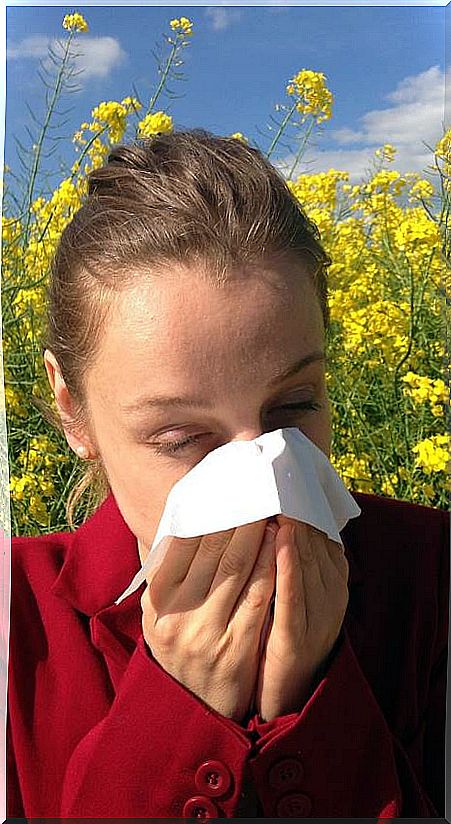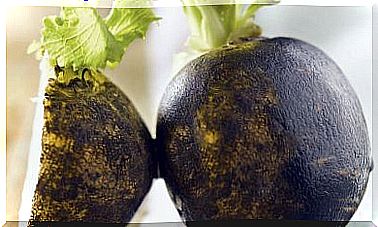The Best Home Remedies Against Allergies
We are entering the allergy season. If you suffer from symptoms, before using antihistamine medications, try the home remedies that we present.

- Allergy or cold?
- Diagnosis and treatment of allergies
- Preventive measures during allergy season
- Home remedies against allergies
More and more people are suffering from one or more allergies, which manifest as itchy, watery eyes, and other symptoms. Before turning to drugs such as antihistamines, which are sold without a prescription and are not free of side effects, there are a number of homemade and natural alternatives that can reduce the discomfort of an allergy. If your doctor prescribes antihistamines, natural remedies will give you additional help.
Allergies are due to an intense reaction of the immune system to exposure to agents that are not toxic and do not cause problems for other people. These agents are called allergens, such as plant pollen that reaches us through the air, or substances found in food or in the fabrics of the clothes we wear.
When in contact with an allergen, the body of the allergic person reacts by producing histamine and other inflammatory substances that cause the typical symptoms:
- Itchy, burning, watery eyes.
- Constant nasal congestion or sneezing.
- Headache or stomach pain.
- Cough, shortness of breath (asthma).
- Itching, redness, or rash on the skin.
Allergy or cold?
Since the symptoms of an allergy also correspond to those of a cold, many people, especially in spring, are not sure if they have a cold or allergy. Thus they can be distinguished:
- By the onset: If symptoms start more suddenly, it is usually an allergic reaction. A cold initially manifests itself as a headache and a sore throat.
- Symptoms that vary throughout the day: In the case of an allergy to house dust, symptoms are worse in the morning than at night, but in people allergic to pollen the symptoms are worse when they are outdoors. The symptoms of colds do not have this variation and follow a typical course.
- Nature of the discharge: in case of allergy, the nasal discharge is watery and transparent. In the case of a cold, on the other hand, it is more dense and can have a yellow-greenish color.
- Additional symptoms: itchy eyes, nose and throat, as well as excessive sneezing indicate rather an allergy. Red and irritated facial skin are also signs of an allergy. However, if you have a fever or chills, in addition to other symptoms, this is more likely to indicate a cold or even the flu.
Diagnosis and treatment of allergies
Classic forms of allergy like pollen allergy and house dust allergy are fairly easy to diagnose. They are usually determined by a test in the dermatologist’s office.
Once the allergy has been diagnosed and the responsible allergen has been unequivocally determined, the patient is prescribed antihistamines, usually in pill form, and instructed to avoid them.
You should be careful with home remedies, for example chamomile helps against gastrointestinal problems, but it can worsen allergy symptoms if you have sensitivity to pollens similar to those of this plant.
Preventive measures during allergy season
- Put pollen screens on windows and doors to balconies and terraces.
- Put specific filters for pollen in your car’s air conditioning.
- Ventilate the house briefly, preferably in the morning when the pollen count is weakest. Avoid leaving the window open at night.
- Read the daily pollen count reports for your city to find out when you can go out on the streets more easily.
- Regular change of bed linen and towels.
- Frequent hair washing, preferably at night.
- If you have severe allergies, install an air purifier in the room that removes pollen and other allergens from the surrounding air.
- Go on vacation to pollen-poor regions (such as the Canary Islands or mountains above 2,000 meters)
Home remedies against allergies
Many allergy sufferers can alleviate their symptoms with natural home remedies. Keep in mind that plants can also cause allergic reactions. Therefore, try the remedy in a small dose before taking it in greater quantity.
Nettle leaves
Many people still see this plant only as a weed, although it has been a medicinal plant for centuries. Take some leaves and dry them. Once dry, prepare an infusion with a tablespoon of leaves for a cup of water.
Two cups of this infusion a day are enough to prevent allergic reactions and relieve symptoms such as itching, runny nose and irritated mucous membranes.
Sea salt
A sea salt solution can also be used as a bath additive to treat itchy skin and rashes. You can use preparations from the pharmacy or you can prepare the salt water yourself.
For a bath with 80 to 100 liters of water (the average bathtubs usually contain approximately 140 liters) you will need approximately 1 kg of sea salt.
A sea salt nasal wash also provides quick relief. The nasal mucous membranes are deflated and it is possible to breathe more easily.
Eucalyptus oil
Eucalyptus oil can help you control allergies. It can be applied in different ways.
- Mixed with peppermint oil (2: 1 ratio) and added to bath water, the oil can relieve symptoms of pain in limbs, headaches, and irritated airways as the oil is absorbed by the body through the skin. and the nostrils
- It can also help with pollen allergy or hay fever. To do this, add a drop of eucalyptus oil to a tablespoon of olive oil. With the help of a cotton swab, you can rub it inside your nose for a few minutes to decongest the sinuses.
Apple vinager
Apple cider vinegar, with its anti-inflammatory properties, has always been used as a home remedy for colds, itching, headaches, and many more ailments.
Apple cider vinegar regulates the pH value in the body and relieves allergy symptoms. Put a tablespoon of vinegar in a glass of water and dilute with a splash of lemon juice and honey. If you have strong symptoms, it is worth drinking the apple cider vinegar mixture three times a day. It is important that you never drink pure vinegar, as the acid can irritate your throat and attack tooth enamel.
Ginger and turmeric
Both are home remedies recognized for their anti-inflammatory properties. Make an infusion with minced ginger or turmeric. They relieve allergy symptoms and slow the release of histamine. The less histamine that is released, the less severe the allergy symptoms will be. At the same time, ginger and turmeric regulate the immune system.
Petasites
This plant mainly helps against asthma by relieving congested airways. The plant is also used successfully against hay fever.
Eyebright
If your eyes suffer during pollen season, you can prepare an eyebright infusion for internal and external use. You can drink the infusion or let it cool a little, take a cotton ball, moisten it and place it on your eyes for a few minutes. You will get quick relief.
Fennel and dill oil
Instead of sea salt or eucalyptus oil, you can steam it with fennel or dill oil. Since the oils are highly concentrated, a few drops are often sufficient, which are placed in a steam bath container.
Place your face over the bowl or saucepan and cover your head with a towel and inhale the fumes. These oils calm the bronchial tubes and thus improve allergy symptoms.
Wet cloth
Put a cool, damp cloth over your eyes. The low temperature reduces swelling and relieves itchiness. Do not use cold packs from the freezer, they are too cold for the eyes and face in general.









